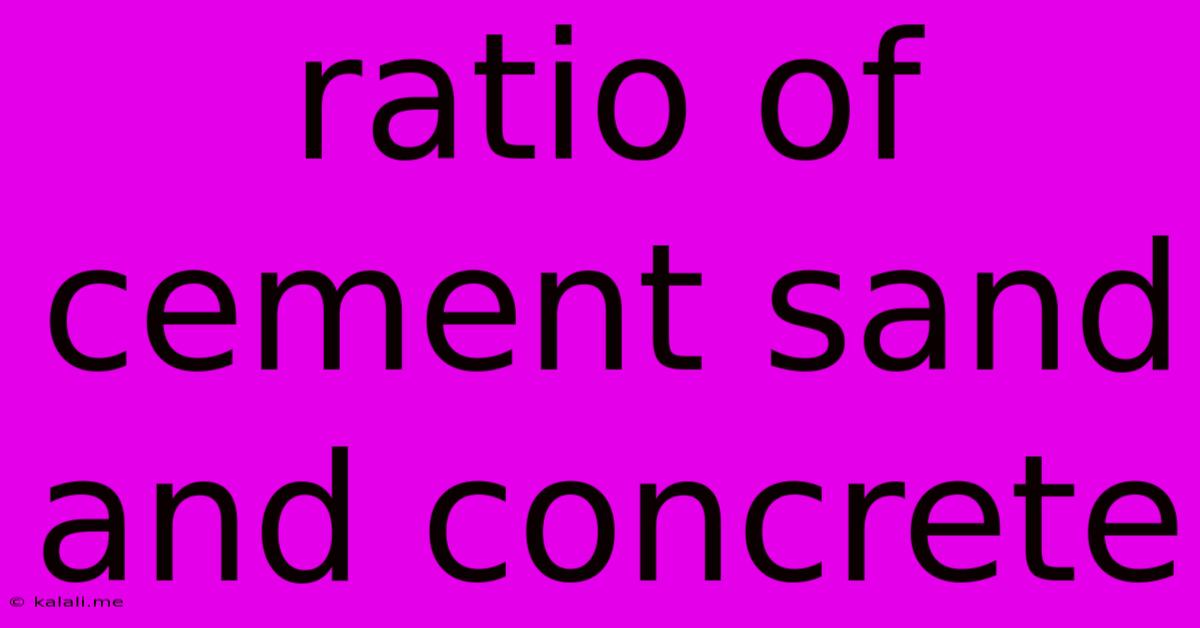Ratio Of Cement Sand And Concrete
Kalali
May 21, 2025 · 3 min read

Table of Contents
The Perfect Mix: Understanding Cement, Sand, and Aggregate Ratios in Concrete
Concrete, the ubiquitous building material, relies on a precise balance of ingredients for optimal strength and durability. This article delves into the crucial ratios of cement, sand, and aggregate (gravel or crushed stone) that determine the concrete mix's properties. Understanding these ratios is key for any DIY project or professional construction endeavor. We'll explore different mix designs, their applications, and factors influencing the ideal ratio.
What Makes Up Concrete?
Concrete is a composite material, a mixture of binder (cement), fine aggregate (sand), coarse aggregate (gravel or crushed stone), and water. Each component plays a vital role:
- Cement: The binding agent that hardens and holds the other materials together. Different types of cement exist, each with varying properties impacting the final concrete's strength and setting time.
- Sand: Fills the voids between the larger aggregate particles, contributing to workability and overall strength. The quality and grading of sand (size distribution) are important factors affecting the mix.
- Aggregate: Provides the bulk of the concrete's volume and contributes significantly to its compressive strength. Aggregate size and type (gravel, crushed stone) influence the mix design and its final properties.
- Water: A crucial element in the hydration process, where cement reacts with water to form a hard, stone-like material. The water-cement ratio is a critical factor determining the concrete's strength and workability.
Common Concrete Mix Ratios
The ratio of cement, sand, and aggregate is typically expressed in parts by volume. Here are a few common ratios and their typical applications:
-
1:2:4 (Cement:Sand:Aggregate): This is a common ratio for general-purpose concrete, suitable for less demanding applications like footings, slabs, and pathways. It offers a balance between strength and workability. This is often referred to as a lean mix.
-
1:1.5:3 (Cement:Sand:Aggregate): This mix provides a stronger and more durable concrete suitable for structural elements such as columns, beams, and foundations requiring higher compressive strength. This is considered a medium strength mix.
-
1:1:2 (Cement:Sand:Aggregate): This is a rich mix, providing high strength and durability. It's commonly used for high-strength applications such as high-pressure pipelines or specialized concrete structures.
Important Note: These ratios are approximate guidelines. The optimal ratio depends on various factors, including the desired strength, the type of cement and aggregates used, and the workability requirements.
Factors Affecting the Ideal Ratio
Several factors influence the ideal cement, sand, and aggregate ratio:
- Strength Requirements: Higher strength requirements demand a higher cement content and potentially a modified aggregate-to-sand ratio.
- Workability: The ease with which concrete can be placed and finished. A higher water content increases workability but reduces strength. Adding admixtures can help to improve workability without compromising strength.
- Type of Aggregate: Different aggregates have different densities and particle size distributions. This will affect the optimal proportions in the mix.
- Environmental Conditions: Temperature and humidity can influence the setting and curing of concrete. Adjustments to the water content might be necessary based on environmental factors.
Beyond the Basics: Achieving Optimal Concrete
While these ratios offer a starting point, achieving optimal concrete requires more than just mixing the ingredients correctly. Proper mixing, sufficient curing, and quality control are essential for producing durable and strong concrete. Consulting with a qualified concrete professional is recommended for critical structural applications. Understanding the principles behind the ratios, however, provides a crucial foundation for any concrete project, allowing for informed decisions and successful outcomes.
Latest Posts
Latest Posts
-
Can A Jew Marry A Non Jew
May 22, 2025
-
How To Go Into 3rd Person In Minecraft
May 22, 2025
-
How To Stop Filler Showing Through Paint
May 22, 2025
-
How Many Teabags For A Teapot
May 22, 2025
-
Do You Need A Tv Licence To Watch Twitch
May 22, 2025
Related Post
Thank you for visiting our website which covers about Ratio Of Cement Sand And Concrete . We hope the information provided has been useful to you. Feel free to contact us if you have any questions or need further assistance. See you next time and don't miss to bookmark.